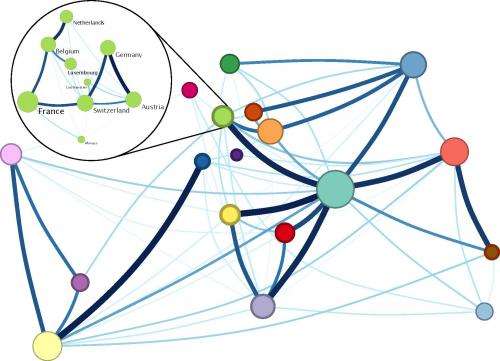Each coloured circle shows a group of countries that have similar information interests. The links show the connections between the groups. The location of the circles are roughly the geographical location of the majority of countries in that group.
According to Fariba Karimi, network scientist at Umeå University, analysis of massive online data can reveal what information matters to us and with whom we have most in common. For example, networks can be used to study how information travels from one part of the world to another. She defends her thesis on Friday 20 February.
With the globalization of technology, everyone has access to all types of information online. But does the globalization actually make people's opinions and interests come closer together? Fariba Karimi and her collaborators addressed this question in one of her thesis studies, where they investigated how people edit content on Wikipedia.
The results show that people care about local and regional information related to sports, media, celebrities or local places. Moreover, people from countries with similar language or historic backgrounds care about similar information.
"We share similar interests in information with those that we share common language or history. The results of this study also reveal which countries have a similarity in information interests, something that has not been studied before" says Fariba Karimi.
For example in Europe, countries are divided into eight clusters. Scandinavian countries are in one cluster with shared interests, while Portuguese and Spaniards have more interests in common with Brazilians than with other Europeans.
"We can project these similarities in a network where countries are nodes and links represent the strengths of similarities. These networks can be used to study how information can travel from one side of the world to the other" says Fariba Karimi.
By extracting patterns from raw datasets from social and economical interactions it's possible to analyse how information, diseases or financial crises can be spread in the networks. Network analysis is now used to prevent major epidemics, like Ebola.
On a daily basis our friends and colleagues constantly influence us in different ways, from social interaction during coffee breaks to online social media.
"These social interactions happen in time and depending on the time the influence might differ. For example, if you want to buy a smartphone, you consider your recent discussions with friends and colleagues about different phones. Or people check their social media on specific times during working hours. Time can therefore be an important factor in spreading processes in networks. But previous network modelling did not take the time component into account" says Fariba Karimi.
The thesis shows that taking time into consideration makes the spreading dynamic different compared to static networks.
"This is important, because it can help us to better understand the spreading processes in real social systems that are mostly dynamic and change over time" says Fariba Karimi.
More information: The thesis is available online: umu.diva-portal.org/smash/get/ … 83857/FULLTEXT01.pdf
Provided by Umea University






















